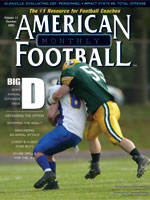AMERICAN FOOTBALL MONTHLY THE #1 RESOURCE FOR FOOTBALL COACHES
Article CategoriesAFM Magazine
|
No Fly Zone: Containing the Air Raid OffenseWith the growing number of high-powered aerial offenses, how do you stop the onslaught?by: Dan Weil © More from this issue Letís say youíre going up against a team with a potent air raid offense Ė a team like Texas Tech, or Boise State or Louisville. How do you stop these pass-happy attacks? We asked five coaches of college and high school teams around the country with outstanding pass defenses. The coaches have a wide variety of suggestions ó from constantly changing your formations to physically intimidating the opposition. They offered strategies of how to pressure the quarterback; details of preparation throughout the week, including drills, tape sessions and strategy meetings; and they told us what kind of adjustments they make during the game. To top it off, each coach listed the three most important factors to stop a powerful passing team. Here is what the five coaches had to say: They agreed that itís important to give th....The full article can only be seen by subscribers. Subscribe today!
|
|
|||||||
| HOME |
MAGAZINE |
SUBSCRIBE | ONLINE COLUMNISTS | COACHING VIDEOS |
Copyright 2025, AmericanFootballMonthly.com
All Rights Reserved





